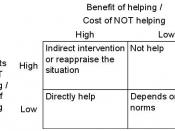Social Exchange |
�
Social Exchange
Intro:
In Peter M. Blau's chapter, "Exchange and Power in Social Life", he uses social exchange and social attraction to explain how social order emerges. Blau's theory can be used to explain how and why people choose to interact, disregard, or follow certain people, government policies, or demands. By understanding how social exchange and social attractions work, it can be used to explain why social order cannot emerge spontaneously. By explaining how social exchange and social attraction work, these processes can be used as examples explain why social order emerges.
Theory:
Blau's theory seeks to explain why individuals associate with others to form groups. He explains this by using a term he calls social exchange. This means that social behavior only occurs in terms of an exchange process. Before this social exchange can occur, Blau states that there has to be social attraction. Social attraction is, "the force that induces human beings to establish social associations on their own initiative and to expand the scope of their associations once they have been formed" (Blau 1964: 99).
However, this social attraction only can take place if one individual finds that it is in his interests to have this attraction to the other. Therefore, the process of social attraction led to the process of social exchange. The mutual attraction creates the association. For this process to be complete, the exchange has to maximize the benefits and minimize the cost of this exchange. Each player weighs the potential benefits and risks of the social relationship. If the risk outweigh the rewards, the relationship either never takes place or one person will end or abandon the relationship.
However, in the exchange process where one person does not have anything to offer the other, there are four alternatives to...


